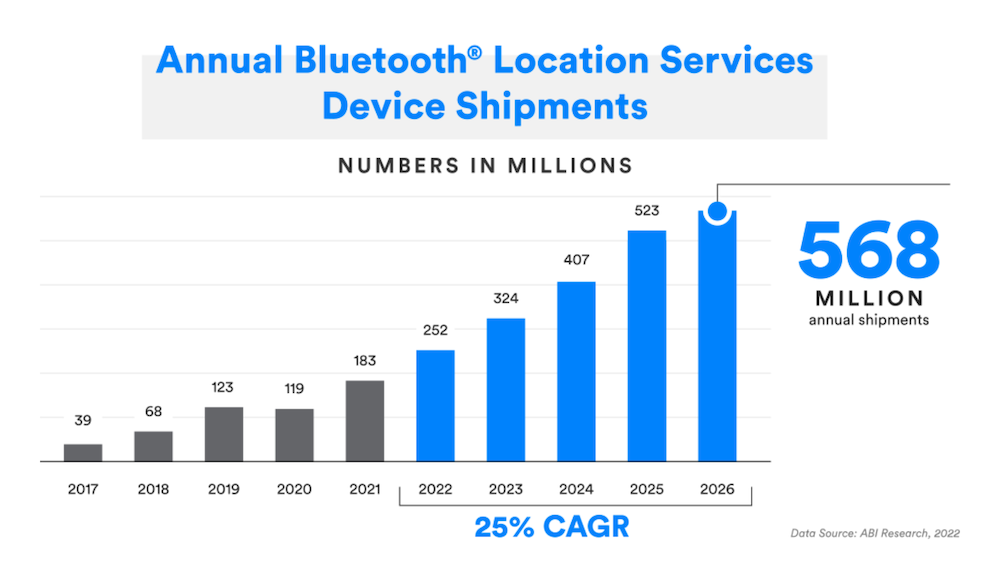What makes Bluetooth beacon-based RTLS systems successful?
183 million, that’s how many location-services Bluetooth® devices shipped in 2021 alone! What’s even more impressive is that annual shipments are expected to reach 568 million in 2026 – that’s over 3x growth and 25% CAGR in the next 5 years! [1]
So, what do we mean by location services? “Location services” refers to any application that leverages the positions of one or more devices within a system to provide meaningful information to the user or trigger operations based on this information.
Some examples include proximity solutions (near, far, out of range, etc.), asset and people tracking, indoor navigation, Digital Key, and personal item finding. Of those applications, Bluetooth asset tracking devices are expected to experience significant growth with about 350 million of these devices forecast to ship in 2026. [2]
Bluetooth Beacons
The most prominent technique utilized in location services applications is the use of Bluetooth beacon technology. Bluetooth beacons are simply Bluetooth-enabled devices that send out data in advertisement packets in a standardized format, and most commonly operate in transmit-only mode. The way that beacon-based positioning systems work is by deploying both beacons and locator devices throughout an area of interest. The beacons send out contextual data in the advertising packets and it is the responsibility of the locator devices to detect the presence of the beacons and determine their positioning within the area.
There are two main aspects of Bluetooth beacons that are leveraged to create a meaningful location services system:
The Received Signal Strength Indicator (RSSI) of the beacon
The data broadcasted by the beacon in the advertising packets
The RSSI values read from a transmitting beacon are used in a calculation or algorithm to determine the position of that beacon device. The advertised data relays important pieces of information that can provide some context of the device (Tx power, namespace information, sensor-related reading, etc.).
Received Signal Strength Indicator (RSSI)
The accuracy of the RSSI values is especially important to achieve increased confidence in the location or proximity of the beacon. The use of RSSI utilizes the Bluetooth radio as a positioning radio instead of in the traditional sense of simply exchanging data between devices.
For the RSSI values to be accurate, the transmit power must be consistent across the three primary advertising channels. This depends on the RF design of the beacon device. Otherwise, the beacon locator devices would have to accommodate for this RSSI inaccuracy across the advertising channels using advanced algorithms implemented in software or firmware.
Depending on the properties of the system deployed (e.g., number of locator devices, antenna design of the beacons, etc.), an RSSI-based system may not achieve high levels of location accuracy. To address this, a recent version of Bluetooth (version 5.1 of the Bluetooth Core Specification) introduced a new feature called Direction Finding, which utilizes Angle of Arrival (AoA) and Angle of Departure (AoD) techniques to determine positioning. This new feature has the potential to enable Bluetooth-based location solutions to achieve centimeter-level accuracy.[3]
When low cost is a higher priority than increased accuracy, RSSI-based systems might provide sufficient accuracy levels. Additionally, the level of accuracy can be further increased in RSSI-based systems by increasing the number of locator devices.
Critical Parameters for Successful Beacon Deployments
There are a few critical parameters that determine how successful a beacon-based location services system is:
Usability: that includes ease of deployment as well as ease of use of the system. Ease of use leads to lower overall system costs.
Low power consumption: lower power consumption leads to longer battery life, hence lower overall maintenance costs and ease of use.
Low cost: the cost of a single beacon device can greatly affect the overall cost of the system, especially when a deployment involves hundreds or even thousands of beacons.
Accurate Tx Power across advertising channels: accurate Tx power values lead to simpler systems since it alleviates the need to employ algorithms to accommodate for inconsistent RSSI reading. This leads to lower system costs.
Security: some deployments may require higher security and privacy measures to protect the data and prevent third-party attackers. In this case, the security level of the system is crucial to the success of the deployment.
InPlay Inc. NanoBeacon™ Technology
IN100 NanoBeacon™ SoC
InPlay's newly launched NanoBeacon™ IN100 SoC has been certified by Bluetooth SIG as compliant with Bluetooth Core Specification 5.3. As the world's smallest Bluetooth beacon SoC that requires no software programming, the IN100 significantly lowers the technology barrier and provides developers with a true configure-and-use development experience for a variety of wireless IoT applications, such as real-time asset tracking, cold chain management, industrial wireless sensing, healthcare monitoring, etc.
With a package size as small as 2.5mm x 2.5mm, this IN100 SoC is the ideal solution for enabling location services solutions. The IN100 supports various types of sensor interfaces, including analog and digital sensor interfaces. Developers can easily connect the IN100 to a sensor, configure its threshold, and once the threshold is reached, wirelessly publish alerts or raw sensor data information via its Bluetooth air interface. The IN100 beacon device recently won RFID Journal’s Best New Product Award of 2021, and it’s only the first SoC in the NanoBeacon™ Technology family chipsets.
Other key features of the IN100 include:
Broadcast-only design
Ultra-low cost
Ultra-low power consumption (as low as sub microwatt to support multi-year operation lifetime)
Easy-to-use and programming-free design: no firmware is required
Consistent Tx power levels at each advertising channel
Support for Long-range mode (Coded PHY)
Wide range of operating temperature: -40C – 125C
Enhanced security for authentication and privacy
Support for Eddystone and iBeacon standards
Support for sensor connectivity including GPIO, I2C, ADC, and 1-wire
[1] [2] Source: 2022 Bluetooth Market Update
[3] Source: Enhancing Bluetooth Location Services with Direction Finding



